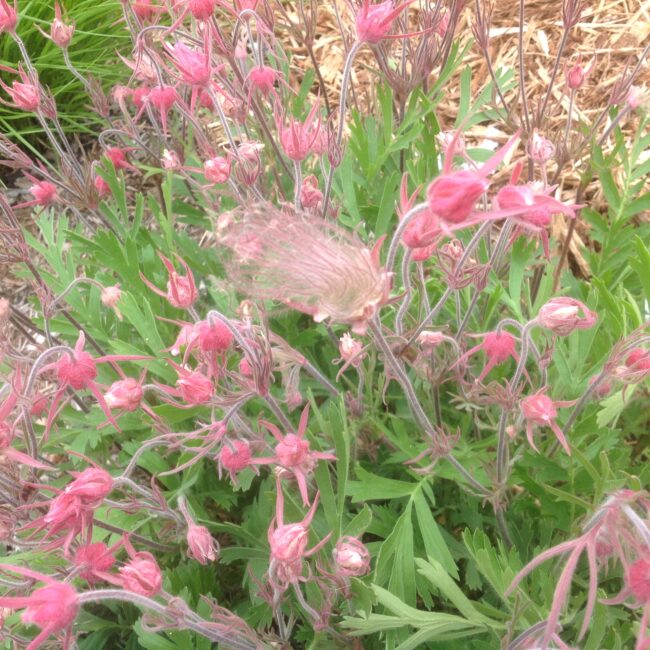A lot of great plants are in bloom here at the Teaching Garden! Native spring wildflowers, non-native perennials, groundcovers and various trees and shrubs are all blooming! Here are some of the highlights.
Native Wisconsin Spring Wildflowers Two native plants that grow in open woodlands, meadows or prairies are shooting star Shooting Star plants (also called American cowslip and prairie pointer) and golden Alexander (Golden Alexander) .


Shooting stars vary in color from white to lavender to magenta. They are delicate 9-15” tall plants that go dormant in June or July. They are usually found in partly shaded to fully shaded areas. A number of native bees really love this plant!

Golden Alexander (also called Zizea, its genus name) will take some shade (ours is in part shade under the edge of the hackberry tree canopy) but is more often found in sunnier areas of meadows and prairies. It is a member of the carrot family, and has the typical flat-topped umbel of tiny florets that compose the flower head. The plant forms a nice clump and is about 15-20″ tall. It is a host plant for black swallowtail butterflies, so I eagerly check it for caterpillars. None so far this year.
A third native plant is one of my favorites: prairie smoke (prairie smoke), also called old man’s whiskers.

This is a shorter prairie or open woodland plant that needs good drainage. It has feathery highly dissected leaves and nodding pink flowers. These don’t open until the flowers are pollinated, so bees need to force their way in to pollinate them. Once pollinated, flowers slowly turn to be upright instead of nodding, and the ‘smoke’ from the common name appears as the fluffy, wispy styles elongate and protrude from the flower. Not too many are ‘smoking’ right now, but I found one that is!

Non-native perennials: Our Rock Garden has a nice specimen of Verbena ‘Lizzie’ (Lizzie vervain) blooming right now. ‘Lizzie’ is a low-growing, blooming powerhouse! It blooms literally all season if in enough sun. ‘Lizzie’ is not a real dense plant, but the amount of flowers and their long bloom time make up for this. ‘Lizzie’ is a groundcover though, so you need a bit of real estate to accommodate its spread. Ours in the rock garden is about 8″ tall and 24″ wide. The one in the Welcome Garden by the front door of the building is not that large a clump yet, but still makes a great show.

A plant in the Welcome Garden (as well as the Wet Garden) that is blooming is ‘Feuerhexe’ (or Fire Witch) dianthus. This is a very short (3-6” tall) clump-forming plant that grows in full sun and slowly spreads over time. It has amazing powder-blue grass-like foliage that looks great even when the plant is not flowering. But the flowers are pretty amazing too. They are fringed and bright magenta pink, with a strong clove fragrance that perfumes the air. I like to use them on top of walls or along stairways so people have their noses and eyes closer to the plant to enhance the experience. You should deadhead the flowers, clipping them off close to the top of the foliage after bloom. This will encourage more flowers to form.

It is sure fragrant by the front door of the building! We have a specimen of A large shrub/small multi-stem tree with great fragrance by the front door is the U.S native Eastern fringetree . This tree produces masses of white, confetti-like flowers. It is a show-stopper in bloom both for visual and olfactory effects. Once the flowers drop, the tree has large shiny green leaves – these turn bright yellow in fall. It is not a real dense plant, so the one at my house is festooned with a solar light string. It is a good one for growing part-shade-tolerant small-scale clematis up the main trunks as well.


Our dwarf Korean lilac is in bloom in the Welcome Garden, and the dwarf Korean hybrid Bloomerang™ Dark Purple Lilac is flowering in the Heuchera Garden. Dwarf Korean lilacs bloom after the common lilacs are finished for the season, so they are great for extending the all-too-short lilac season! The Bloomerang™ series have a heavy bloom in May, but then continue blooming lightly through the season. Both of these shrubs are powdery mildew-resistant, as well!



Trees:
The ‘Fort McNair’ red horse chestnut is in full bloom in the Naturalistic Garden, and it is a wonderful sight to see. The large pink flower clusters (about 8” tall) stand upright at the ends of the branches and are beautifully displayed. This tree has a rounded shape and slow to medium growth rate and stands at 35-40′ at maturity. The 5-parted palmately compound leaves are another attractive feature of this tree. Unfortunately, they are susceptible to a leaf blotch disease that causes large, brown dead spots on the leaves by about the end of June, so we do treat our tree for that. But it is sure spectacular this time of year!






